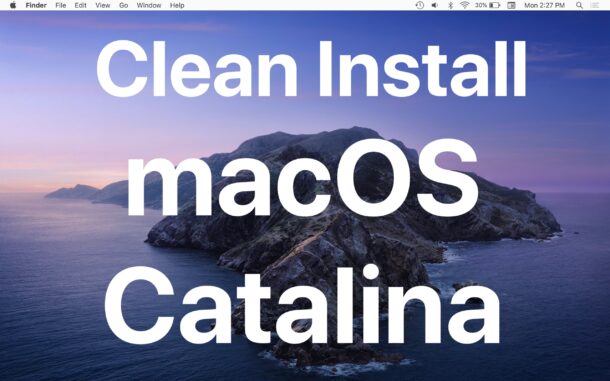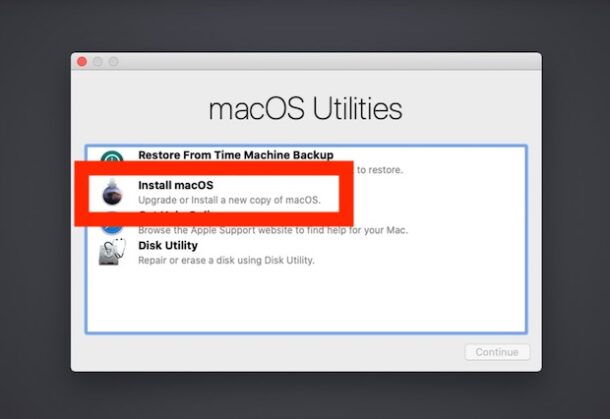How to Clean Install MacOS Catalina

Some Mac users may wish to perform a clean install of MacOS Catalina onto a Mac. A clean install represents a fresh start, and it’s achieved by erasing all data from the Mac hard drive and then performing a fresh clean installation of MacOS Catalina onto that Mac. A clean install sort of feels like getting a new Mac in the sense that no data is on the device at all, there are no apps, no user accounts or user data, no system preferences or customizations, there is nothing left on the Mac at all, it’s just a blank new installation of MacOS Catalina.
Clean installs are not recommended for most Mac users and because the hard disk is erased it has potential to cause permanent data loss, so this is really only appropriate for advanced users with a compelling reason to format their Mac and start over, or if someone is selling a Mac or transferring ownership, or otherwise. Be sure you have a complete backup of your Mac and all important data made before proceeding.
A clean install of MacOS Catalina 10.15.x requires the following:
- The Mac must be compatible with macOS Catalina
- Have aMacOS Catalina boot USB installer drive already made and ready to use
- Have a complete backup of the Mac and all important data made, use Time Machine to backup or another thorough backup method of your choice.
It’s important to remember that a clean install will erase all data and everything on the Mac. All personal data, apps, files, and anything on the Mac is erased in this process. Failure to have sufficient data backups may result in permanent data loss, so proceed at your own risk.
How to Clean Install MacOS Catalina
Warning: This erases everything on the Mac. Do not proceed unless you are comfortable removing all data and have backups made.
- Complete a full Time Machine backup before beginning – do not skip making a full backup
- Connect the MacOS Catalina installer drive to the Macs USB port
- Reboot the computer
- Immediately hold the OPTION key until the boot selection menu appears on the display, then choose the “Install MacOS Catalina” drive at the boot menu
- At the “macOS Utilities” screen, choose “Disk Utility”
- In Disk Utility, select “Macintosh HD” (or the name of the disk to erase and clean install Catalina onto), then click the “Erase” button
- Choose “Macintosh HD” as the name, then go to “Format” and select APFS, then choose “Erase” – WARNING: THIS ERASES ALL DATA ON THE MAC
- Quit Disk Utility when finished formatting the disk
- At the ‘macOS Utilities’ screen again, select “Install macOS” from the options
- Select “Macintosh HD” as the destination to install MacOS Catalina, then choose “Install” to begin clean installing MacOS Catalina


This will begin the process of clean installing MacOS Catalina onto the Mac, it may take a while to complete. The Mac will reboot itself automatically during the process, let it finish and do not interrupt the installation.
After the clean install of Catalina has completed, the Mac will boot back into a fresh and new installation fo MacOS Catalina, similar to getting a new computer and turning it on the first time.

Because the Mac was erased during this process, there will be no personal files, no apps, no preferences, no settings, no customizations whatsoever on the Mac, it will be as if it is new, which is why this is colloquially called a “clean install” in the tech world.
The Mac will basically appear as if it’s new at this point, and you’re free to either restore data to it from backups, or to start fresh without restoring or copying any anything to the computer again.
Some users may opt to perform a clean install as a troubleshooting method if they experienced frequent issues with their system software. Nonetheless if you are encountering problems with MacOS Catalina, check out this troubleshooting guide for help addressing macOS Catalina problems.
Were you able to successfully perform a clean install of MacOS Catalina? Do you use another approach to clean install Catalina? Let us know your experiences and thoughts in the comments.


REMEMBER TO SIGN OUT OF ICLOUD
Thanks for the instructions. Followed them and it all worked as expected. Except I rushed in to the install, and didn’t sign out of iCloud. All the documents/items originated on the Mac… lost. (Except, I followed the advice and did a TimeMachine back up! Yay.)
OK, created my bootable USB flash drive.
And I can boot from that drive.
But, when I get to MacOS Utilities in Recovery Mode, my bluetooth mouse doesn’t work! Works fine normally but not in Recovery Mode so I can’t access Disk Utilities to erase my internal HDD.
I see this problem was reported in 2017 …
Suggestions for a clean install of Catalina which doesn’t use a Mouse, or am I going to have to try to find a USB mouse!
Thank you Paul. I have another question if you don’t mind. Can I use my 16 inch MacBook Pro with Secure Boot as medium security and Allow booting to boot from external media without having any problems when doing updates? T2 chips machines use by default Secure Boot as Full Security and do not allow booting from external media. I want to have full control of my machine without having to do CMD+R constantly.
Btw, if make a fresh install with a USB pendrive with secure boot as medium security, if after that I change that feature to full security I will have problems?
Thank you.
Hi,
I have to download macOS Catalina image from App Store of the machine that I want to make a fresh install or I can download macOS Catalina image from App Store of other machine and create a bootable USB pendrive of macOS Catalina in that machine and use that bootable pendrive installer on the machine that I want to make a fresh install?
Thanks
You can download Catalina from the App Store on any Mac which supports Catalina, and then use that installer to build a boot USB drive which works with any other Mac that is also compatible with MacOS Catalina.
As long as the Mac is compatible with MacOS Catalina it will work fine, either to download the installer or to boot from and install Catalina onto.
The Catalina 10.15.6 was a big update at around 2.8Gb! Took awhile to upgrade my older Mac Mini too. I am experiencing some issues now with Safari not loading some web sites as well after upgrade.
I have done this a couple of times and recall seeing two volumes in Disk Utility – “Macintosh HD” and “Macintosh HD – Data” – both of these had to be erased and then a clean install could be made.
I am not sure if there is an order to which they should be erased.
Nope. It was bad enough that Mojave turned my iPod into a $350 brick and now Catalina and it’s “improvement” Big Sur will trash iTunes and all my radio stations. Nope, I’ll stick with Mojave until I have to upgrade to a new computer.
I continue to use MacOS Mojave on two of my Macs as well, because they still require iTunes and 32-bit app support, neither of which is available in MacOS Catalina.
If Mojave works fine for you, it’s OK to continue to use it. Don’t forget to install the Security Update packages that get released for it from time to time. Some users still use Mavericks and even Snow Leopard and earlier releases, it all depends on personal use case and what is necessary for a particular workflow. MacOS Catalina works great for some users but not for others, and some of the changes make Catalina impractical for use (like if you require 32-bit app support).
What’s the issue with the iPod and which model is it? Have you tried updating and restoring it?
After installing Catalina will it be easy to reinstall the apps I have backed up on the external drive?
Apps are best reinstalled from either the Mac App Store, the developer websites, or the installation medium they came with. For a true fresh start with a clean install, most users don’t want to bring existing data and configurations over anyway, but that means everything must be reconfigured and setup again – admittedly, a hassle.
A variation is to backup the entire Mac with Time Machine, then perform the clean install of MacOS Catalina, then transfer data back to the Mac or restore data from that backup. That’s still fairly time intensive and more complicated than a simple update to macOS Catalina, however.
Clean installs are usually best for selling a Mac or transferring ownership, or as a far-along troubleshooting method if something with the system software is really awry. Because they’re a hassle to reconfigure everything, reinstall apps, transfer personal data, etc, to get everything back to how it was prior to the clean install, it’s not widely used for simply updating macOS.
My question is how do you re-install your apps, documents, and data without getting all the “crap” that has accumulated over the years. In other words, how do you get a “clean install” of your data, now that you have a clean install of your OS?
For a true clean install, starting from scratch means literally re-installing all applications onto the Mac, either from the Mac App Store, or downloaded from their respective developer websites.
Likewise, reconfiguring settings and other adjustments to MacOS and apps is then necessary if you don’t want to bring over any accumulated preferences, plists, and other files.
As for personal data and documents, if they’re stored within the user folders (like ~/Documents, ~/Pictures, etc) they can be copied directly over to the user folder on the clean install, from an external hard drive or a backup source. For personal data that is kept within particular applications, it’s a bit trickier and depends on those individual apps and where they store stuff.
The clean install process is relatively easy, but getting everything setup and configured again can be time intensive and kind of a hassle, which is part of why it’s not widely used. For the majority of users, it’s much easier to simply update an existing macOS installation.